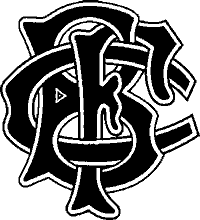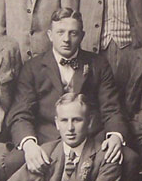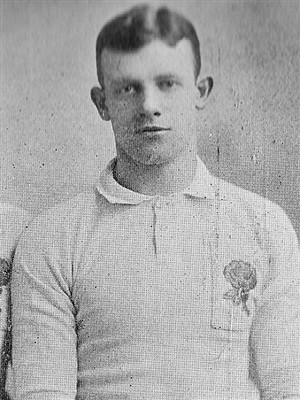
Barry John was a Welsh rugby union fly-half who played in the 1960s and early 1970s during the amateur era of the sport. John began his rugby career as a schoolboy playing for his local team Cefneithin RFC before switching to the first-class west Wales team Llanelli RFC in 1964. Whilst at Llanelli, John was selected for the Wales national team—as a replacement for David Watkins—to face a touring Australian team.

The Barbarian Football Club, known as the Barbarians, is a British-based invitational rugby union club. The Barbarians play in black and white hoops, though players wear socks from their own club strip. Membership is by invitation. As of 2011, players from 31 countries had played for them. Traditionally at least one uncapped player is selected for each match.
Michael Clive Teague is an English rugby union player who played for the British Lions.

Charles "Boxer" Joseph Russell was a pioneer Australian rugby union and rugby league footballer and coach. He represented his country in both sports and was one of Australia's early dual-code rugby internationals. He was a gold medallist at the 1908 Summer Olympics.

William Purdon Geen was a rugby union wing and centre, who represented Wales, and played club rugby for Oxford University and Newport and county rugby for Monmouthshire. He was also invited to play for the Barbarians on several occasions. Geen unsuccessfully trialled for England in 1910, but was selected and played for Wales on three occasions in the 1912–1913 season. Injury prevented him from playing more internationals, and his service in the First World War put an end to his career.

Thomas Smyth was an Irish international, rugby union prop forward who played club rugby for Newport and Malone and invitational rugby with the Barbarians. He won fourteen caps for Ireland and was selected to captain the British Isles 1910 tour of South Africa, and played in two of the test games.

Albert Melville "Mel" Baker was a Welsh international, rugby union wing who played club rugby for Newport and South African regional team Griqualand West. He won three caps for Wales and was selected for the British Lions 1910 tour of South Africa.

Greig Laidlaw is a Scottish former professional rugby union player who played as a scrum-half and as a fly-half. Laidlaw holds the record for most caps as captain, 39, of the Scottish national team. He also represented the British & Irish Lions in 2017.
Howard Marshall OBE was an English rugby union half-back who played club rugby for Blackheath and Richmond and was a member of the first official British Isles tour in 1891. Marshall played just one game for England, scoring a hat-trick of tries on his debut. It is thought, through historical records and the detective work of Sunderland based sport and social historian Keith Gregson, that Marshall sustained a severe knee injury which curtailed his rugby career.
David John Thomas was a Welsh international forward who played club rugby for Swansea Rugby Club. He won ten caps for Wales and is most notable for scoring the only try in Swansea's win over South Africa in 1912.

Frank Moxon Stout MC also referred to as Frank Moxham Stout, was an English international rugby union forward who played club rugby for Gloucester and Richmond. Stout played international rugby for England and was selected for the British Isles on two tours in 1899 and 1903. On the 1899 tour of Australia, he acted as on field captain for three of the Tests.
William Thomas Charles Cave was an English international rugby union forward who played club rugby for Cambridge and Blackheath. Cave played international rugby for both the British Isles and England, and was also selected for invitational team the Barbarians.
Lt. Colonel Gilbert Faraday Collett DSO was an English sportsman who was an international rugby union wing and first-class cricketer for Gloucestershire County Cricket Club. As a rugby footballer he represented Cambridge University and Cheltenham at club level. Collett also played international rugby for the British Isles during the 1903 tour of South Africa but was never selected for the England national team.
Maurice John P. Daly was an English player of rugby union football, who played internationally for both Ireland and East Africa. Along with W.B. Young of Scotland he is one of only two people to have been capped by a major rugby playing nation and by East Africa.
Charles Henry "Cherry" Pillman was an English rugby union international who played on 18 occasions for his country and was part of the first official British Isles team that toured South Africa in 1910. He played club rugby with Blackheath and county rugby for Kent. Pillman's speed and tactics made him one of the leading exponents of an attacking wing forward, now recognised as the flanker position.

Paul Geoffrey Allen Johnstone was a South African rugby union wing. Johnstone played club rugby in South Africa for Paarl, Hamiltons, Villagers, Pirates and Berea Rovers; and in the UK for Blackheath He played provincial rugby for both Natal and Western Province. He was capped for South Africa nine times between 1951 and 1956 first representing the team on the 1951–52 South Africa rugby tour of Great Britain, Ireland and France. The touring team is seen as one of the greatest South African teams, winning 30 of the 31 matches, including all five internationals.

Percy Wyfold Stout DSO, OBE was an English international rugby union wing who played club rugby for Gloucester and Richmond. Stout also played international rugby for England, playing five matches between 1898 and 1899.
Robert Hoskins Lloyd is a former rugby union player who played for Clifton RFC, Harlequins, Surrey, Barbarians and the England national rugby union team.

Arthur "Mud" James Dingle was a rugby union centre and wing, who won three caps for England, and played for County Durham, Hartlepool Rovers and Oxford University.
Douglas "Dan'l" Lambert was an English rugby union footballer for Harlequins, England, and the Barbarians. He won 7 caps for England between 1907 and 1911, notably scoring 5 tries on debut against France, and 22 points in another match against France. Lambert was all round sportsman: he was a scratch golfer, played football (soccer) for Corinthian Casuals, and kept wicket (cricket) for Hertforshire. He was killed in action at the Battle of Loos on 13 October 1915.











